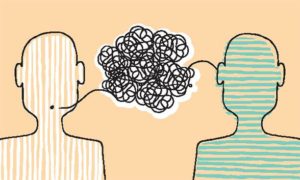https://www.youtube.com/watch?time_continue=1&v=cPnfjwKfkSk
As a rapid consumer and fan of all things design, I like to consider how the things we look at are determined visually; for example, I think it’s important to analyze which elements of an advertisement serve our best interests, as well as which elements manipulate our perception of the product or service being advertised.
Consider the video above; the advertisers manipulated the image in some ways that seem wrong, while others seem ethically sound or expected. Lengthening the legs, lightening the skin, and elongating the neck of the model were arguably not within the viewer’s best interest, while the addition of makeup doesn’t seem quite as immoral.
To me, the core practice “Communicate clearly, respectfully, and honestly,” maintains an intuitive connection to visual communication. In a world ordered by visual stimuli, design ethics have become more important than ever. Thus, my central research question is: What does it mean to communicate honestly in advertising?
Good Design is…
In a 2014 article for “Open Port,” European design firm Port Clarendon’s online blog, author Daniel Lingini says, “[Good design] does not make a product more innovative, powerful or valuable than it really is. It does not attempt to manipulate the consumer with promises that cannot be kept.”
A 1996 report by Sam Dragga of Texas Tech University, relating the results a national survey of 500 technical communicators and 500 technical communication teachers, considered the ethics of design. With few solid outlines for designers regarding how to adhere to ethics systems, they must rely on their intuition and professional communities to inform their choices.
Obviously, this may present external dilemmas. For example, individuals’ experiences can influence their perceptions of ethics. Overall, designers should be committed to minimizing manipulation in order to produce ethical work.
More simply, good design is honest.

The Eye of the Consumer
Jodi Forlizzi and Cherie Lebbon assert in their 2002 article that consumers today are diverse in age, income, and ability; have a wider variety of expectations, influences, and education; and more exposure to visual stimuli.
They write, “Effective rhetorical communication allows individuals to relate to each other, provides a vehicle for expression, freedom, and the discovery of truth, and ultimately, creates the possibility for social agreement within a pluralistic society. However, if designers attempt to persuade audiences through [dishonest] visual messages, without properly understanding who they are designing for, inappropriate outcomes can result” (Forlizzi, Lebbon 4).
Though not quantitatively focused, the claims Forlizzi and Lebbon make stem from the communication studies discipline, using advertising as a foundation for larger discussions about honest communication and visual depiction. When dishonesty is present within visual messages, communication is at worst compromised and at best warped.
Newspaper Wins
Ernest Larkin, professor of journalism at the University of Oklahoma, did a study funded by the American Association of Advertising Agencies in 1979. For this study, a random sample of 150 individuals was drawn from the telephone directory of a Southwestern city of 80,000. A mail questionnaire was used to elicit information from this sample concerning their attitudes toward the various media, and their stated use of the media with regard to information on news and advertising.
Results of said study indicated that newspapers are the public’s favorite advertising medium. While 12 percent of the respondents felt that newspaper advertising was misleading, 59 percent felt that it was the most truthful, thus making it the first choice among mass media outlets. Magazines were second with 19 percent and television was third with only 11 percent of the total (Larkin 5).
So why do newspapers lead in a perceived truth? One explanation may be their generally straightforward design. Because they represent honesty and integrity in their form, readers may assume that their content, including advertisements follows suit.
There are newspapers that manipulate this position of power to advertise perspectives that are unfounded or outlandish. A famous example of such is fictional paper the Weekly World News’ claim that Hillary Clinton adopted an alien baby in the 1970s.

Challenges
However, Scott Koslow, in his 2000 article “Can the truth hurt? How honest and persuasive advertising can unintentionally lead to increased consumer skepticism,” challenges the notion of honesty always being good.
He writes: “[Consumers] may sometimes be so vigilant against potentially misleading advertisers, that even after claim verification has occurred, consumers sometimes remain skeptical.”
Koslow’s findings depended upon traditional cases of consumer behavior as decided through a synthesis of studies from the 1980s. His analysis, though, is mainly concerned with what happens when honesty is weaponized by advertisers, and how consumers react to such a betrayal.
In Summation
Overall, all of my sources together demonstrate the relationship between advertising and honest communication. Even when considering how this relationship may be harmful, as in Koslow’s case, it’s existence is not disputed.
It is the responsibility of the designer or advertiser to provide consumers with an honest account of a product or service in order to effectively create dialogue that will serve both parties. While Photoshop may seem tempting, either to manipulate messages or to intentionally provoke the viewer, I assert that any level of dishonesty in visual communication does more harm than good.
Advertising Our Abilities as Peer Writing Tutors
As peer writing tutors we must remember to remain honest in our appointments. Much like consumers of visual media, our writers are diverse in their experiences, abilities, and methods.
Rather than using formulaic feedback models that may or may not serve the best interests of an individual writer, we must make a conscious effort to be honest and authentic in our understanding of each appointment. Unlike the video we began this presentation with, we should not use our own power and abilities to recraft the uniqueness of the individual writer to suit our vision of success.
Further yet, we should not allow ourselves to appear more powerful, successful, or skilled than we truly are, but should instead avoid making false promises to both ourselves and our writers.
Sources
Dragga, Sam. “‘Is This Ethical?”: A Survey of Opinion on Principles and Practices of Document Design.” Technical Communication, vol. 43, no. 3, Aug. 1996, pp. 255–265. Ingenta, plaza.ufl.edu/garnold/f08/dragga.pdf.
Forlizzi, Jodi, and Cherie Lebbon. “From Formalism to Social Significance in Communication Design.” Design Issues, vol. 18, no. 4, 2002, pp. 3–13. MIT Press, doi:10.1162/074793602320827389.
Koslow, Scott. “Can the Truth Hurt? How Honest and Persuasive Advertising Can Unintentionally Lead to Increased Consumer Skepticism.” Journal of Consumer Affairs, vol. 34, no. 2, 2000, pp. 245–268. EBSCO, doi:10.1111/j.1745-6606.2000.tb00093.x.
Larkin, Ernest. “Consumer Perceptions of the Media and Their Advertising Content.” Journal of Advertising, vol. 8, no. 2, 1979, pp. 5–7. JSTOR, www.jstor.org/stable/4188248.
Lignini, Daniel. “No. 6 Good Design Is Honest, Dieter Rams.” Port Clarendon, Port Clarendon, 3 July 2014, www.portclarendon.com/openport/good-design-is-honest-dieter-rams.
Discover more from UCWbLing
Subscribe to get the latest posts sent to your email.


